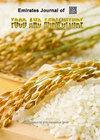Valorization of tropical fruit peel powders: Physicochemical composition, techno-functional properties, and in vitro antioxidant and antidiabetic activities
IF 0.7
4区 农林科学
Q3 AGRONOMY
引用次数: 2
Abstract
This study aims to evaluate the physico-chemical composition, techno-functional properties and in vitro antioxidant and antidiabetic activities of papaya, pineapple and mango peels for their possible use as functional ingredients. The peel powders were found to possess interesting techno-functional properties, high dietary fiber content (37.77 to 62.26%) and phenolic compounds, namely gallic, ferulic, and p-coumaric acid, catechin, quercetin-3-β-d-glucoside and quercetin. They also showed excellent antioxidant activity, as determined by ABTS (3.63 to 29.8 µM TE/g), DPPH (5.76 to 35.3 µM TE/g), NO (60.67 to 86.35%) and O (17.56 to 50.64%). Mango peel powders presented the best ability to inhibit the activity of the different enzymes evaluated: modest α-amylase inhibition (51.40%), stronger α-glucosidase inhibitory activities (70.32%), and moderate antiglycation potential (57.15%). Peel powders of these tropical fruits make them suitable to be used as food ingredients with possible health benefits, improving intestinal function and controlling hyperglycemia. Further studies require animal models and, subsequently, in humans. Keywords: Bioactivities; Nutritional value; Peels; Techno-functional properties; Tropical fruits热带果皮粉的价值:理化成分、技术功能特性及体外抗氧化和抗糖尿病活性
本研究旨在评估木瓜、菠萝和芒果皮的物理化学成分、技术功能特性以及体外抗氧化和抗糖尿病活性,以供其作为功能成分使用。果皮粉具有令人感兴趣的技术功能特性,膳食纤维含量高(37.77%-62.26%),并含有酚类化合物,即没食子酸、阿魏酸和对香豆酸、儿茶素、槲皮素-3-β-d-葡萄糖苷和槲皮素。通过ABTS(3.63至29.8µM TE/g)、DPPH(5.76至35.3µM TE/g)、NO(60.67至86.35%)和O(17.56至50.64%)测定,芒果皮粉还显示出优异的抗氧化活性,这些热带水果的果皮粉使其适合用作可能有益健康、改善肠道功能和控制高血糖的食品成分。进一步的研究需要动物模型,随后需要在人类身上进行。关键词:生物活性;营养价值;Peels;技术功能特性;热带水果
本文章由计算机程序翻译,如有差异,请以英文原文为准。
求助全文
约1分钟内获得全文
求助全文
来源期刊

Emirates Journal of Food and Agriculture
AGRONOMYFOOD SCIENCE & TECHNOLOGY&nb-FOOD SCIENCE & TECHNOLOGY
CiteScore
1.80
自引率
0.00%
发文量
18
期刊介绍:
The "Emirates Journal of Food and Agriculture [EJFA]" is a unique, peer-reviewed Journal of Food and Agriculture publishing basic and applied research articles in the field of agricultural and food sciences by the College of Food and Agriculture, United Arab Emirates University, United Arab Emirates.
 求助内容:
求助内容: 应助结果提醒方式:
应助结果提醒方式:


